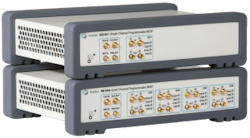- the PG1601 single-channel 14.5-Gbps programmable pattern generator, with prices starting at $34,990
- the PG1604 four-channel 14.5-Gbps programmable pattern generator, with prices starting at $75,990
- the SB1601 single-channel 14.5-Gbps BERT, with prices starting at $45,490
- the SB1604 four-channel 14.5-Gbps BERT, with prices starting at $95,990.
The pattern generators operate from 1.25 to 14.5 Gbps and feature an internal low-jitter, full-rate clock synthesizer and built-in programmable clock divider. They support the generation of PRBS and 20-bit user-programmable patterns.
The BERTs also operate from 1.25 to 14.5 Gbps and feature an internal full-rate clock synthesizer and built-in programmable clock divider, with the capability to support PRBS and 20-bit user-programmable patterns. They also have an integrated clock-data recovery (CDR) system that can derive a clock typically within 10 µs, according to a SmarTest brochure. The pattern generators within the BERT feature rise/fall times (20%-80%) of less than 15 ps and intrinsic jitter (RMS) of less than 1 ps typical. The BERTs weigh 3.3 lbs.
While the instruments are described as 14.5-Gbps platforms, they should accommodate 16-Gbps requirements as well, Lipparini and the company’s literature suggest. The company has its eyes on higher-speed applications as well, with 32-Gbps instruments on the near-term road map, Lipparini revealed.
All of the small, benchtop instruments feature USB control and are simple to set up, the company says. A proprietary expansion bus for synchronization and control of multiple units via a single remote PC controller enables higher channel-count test system configurations. All four of the systems are currently available.
For more information on test equipment and suppliers, visit the Lightwave Buyer’s Guide.

